No Money or False Information Can Change the Fact that Banning Fur and Foie Gras is the Right Thing To Do

(photo: Pixabay License)
Industries that exploit and abuse animals have a lot of money and a lot to hide. Whether it be the fur industry, which abuses and kills animals for their skins, or the foie gras industry, which rams a foot-long pipe down the throats of innocent ducks for a luxury food item, resorting to Trump-like tactics of lies, fear-mongering, and bullying is a telltale sign that you’re on the wrong side of history.
In New York City, we have two of the most abusive and morally bankrupt industries on earth -- fur and foie gras -- spending hundreds of thousands of dollars to spread misinformation and bully City Council members to get them to oppose two common-sense animal protection bills that seek to end the cruelties in their unregulated industries.
A perfect example is the fur industry’s recent blanketing of Speaker Corey Johnson’s district with ridiculous mailers filled with false information. Speaker Johnson should be applauded, not attacked, for working to protect animals.
Another bill, Intro. 1378, would prohibit the sale of force-fed foie gras in New York City. Foie Gras is a luxury food product sold in about 1.5% of New York City restaurants. It is produced by violently shoving a metal or plastic foot-long pipe down a bird's throat, then pumping him with so much feed that, after three times a day for several weeks, his liver becomes grossly diseased and enlarged to ten times its normal size.
The bill is supported by 81% of New Yorkers, according to a Mason Dixon poll, and over 50 New York-based veterinarians, 100 restaurants, and over 60 not-for-profit organizations have endorsed it. The only opposition to this bill is the industry that profits from the abuse. A new poll just release by Fur Free NYC shows a staggering 75% of New York City voters support a ban on the sale of fur.
On fur, Intro. 1476 would prohibit the sale of fur apparel in New York City. Worldwide, over 100 million animals are abused and killed for their fur every year. Whether raised on fur farms in tiny wire cages or trapped from the wild with cruel leg-hold traps, fur-bearing animals -- including foxes, coyotes, wolves, otters, dogs, cats, and raccoon dogs -- have unimaginable cruelty inflicted upon them.
Designers, retailers, and cities around the world are joining together in banning the sale of fur and shutting down fur farms due to the cruelties involved. In the past 18 months, Chanel, Phillip Lim, Jean Paul Gaultier, Coach, Burberry, Gucci, Michael Kors, and more have all banned fur. Here in the United States, the cities of Los Angeles and San Francisco have recently banned the sale and manufacturing of fur, while cities and countries across Europe and Asia are seeking to do the same.
These industries cannot win a civil debate on the merits, so they resort to using their money to bully and spread misinformation to the general public and the City Council—representing everything that is wrong in politics. They’ve hired expensive lobbyists and marketing firms to spin the truth, sent out thousands of mailers and robocalls with misinformation, and bought ads that are riddled with lies to cause fear among New Yorkers. These tactics are from a Trump-like playbook and have no place in this great city.
On the other hand, non-profit groups that advocate for animal rights refuse to entertain these abusive industries’ morally dubious political theater. As Michelle Obama famously said, “when they go low, we go high.” That is exactly what we will do on behalf of animals.
Our coalition of more than 50 organizations will rely on facts, evidence, and science to support the policies we promote. We welcome transparency, debate, and fairness in the legislative process. We operate in the open and don’t try to influence in the shadows. At Voters for Animal Rights, we’re an all-volunteer organization that works to protect animals on an annual budget that is roughly the same as a lobbyist’s monthly retainer to represent the fur industry.
We fight for animals for one simple reason: it’s the right thing to do. They oppose animal protection laws because it threatens their bank accounts.
We are at a pivotal juncture in our society: we can either take back our democracy from powerful, unethical industries or allow those with money to undermine and destroy what makes New York a beacon of light for good. We humbly call on New Yorkers to denounce “alternative facts,” and tell the abusive fur and foie gras industries “No.”
We will not be bullied. We will not stop fighting for the rights of animals. We will not remain silent as they torture innocent animals for profit.
It’s clear that fur and foie gras are products of extreme cruelty and should be relegated to the waste bins of history. Together, we can make New York City a better city by rejecting the fur and foie gras industries’ Trumpian political tactics and pass Intros. 1378 and 1476 without delay.
***
Matthew Dominguez and Allie Feldman Taylor are leaders of Voters For Animal Rights. On Twitter @theanimalvoters.
***
Have an op-ed idea or submission for Gotham Gazette? Email This email address is being protected from spambots. You need JavaScript enabled to view it.
‘Free College’ at One SUNY School Shows ‘Excelsior’ Progress and Problems
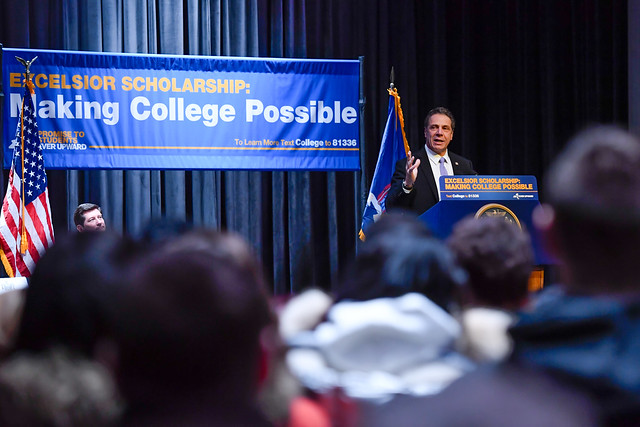
(photo: governor's office)
Governor Andrew Cuomo’s Excelsior Scholarship is increasing credit accumulation and college retention rates, but the program still needs to meet more students where they are at.
In 2017, Governor Cuomo embraced the “free college” movement championed by Senator Bernie Sanders and created New York State’s Excelsior Scholarship. Under Excelsior, students from families with annual incomes below $110,000—and increasing to $125,000 in fall 2019—can go to State University of New York (SUNY) and the City University of New York (CUNY) schools tuition-free.
Excelsior is a “last dollar” scholarship program that pays tuition amounts for full-time students that are not already covered by the federal Pell program and New York State’s nearly $1 billion Tuition Assistance Program. This is one factor that has kept the scholarship’s scale relatively small, covering just 3.2% of SUNY and CUNY students, according to a Center for an Urban Future report on Excelsior’s first year.
In fall 2017, approximately 400 of the 26,000 students at SUNY Suffolk County Community College on Long Island (SCCC) received Excelsior, according to SCCC data that was provided in response to a Freedom of Information Act request. Excelsior awards funds of up to the full cost of tuition, which at SCCC was $2,385 per semester in 2017-2018, or $4,770 per year.
Of SCCC’s 400 or so Excelsior recipients, 300 were first-year freshman students, and 161 of those students, or 53.7%, earned 30 or more credits during their freshman years. Having 30 or more credits at the end of freshman year is a requirement for maintaining Excelsior and is a milestone on the way to graduating in two-years.
SCCC does not report the rate at which its general population of students earn 30 or more credits in their freshman year, yet other public institutions do. For instance, at CUNY, 10.7% of associate degree full-time freshman students earn 30 or more credits as freshmen.
The rate at which the SCCC general population earns 30 or more credits may exceed the CUNY rate by several percentage points, but not by a multiple of two or more given that SCCC's two-year graduation rate of is very similar to the two-year graduation rate for CUNY associate degree students of 7.7%.
Within this context, the 53.7% rate at which SCCC Excelsior recipients earned 30 or more credits extraordinary.
The Excelsior regulations strongly incentivize students toward meeting the 30-credit milestone.
First, students who earn the 30 or more credits annually get to maintain the scholarship. Second, those who fail to meet the threshold must pay back one semester of their Excelsior awards. This means that bills of up to $2,385 faced SCCC Excelsior freshmen who did not meet the 30-credit threshold and did not present a special circumstance warranting an exception, like a parent’s death, or have earned credits from high school dual enrollment programs to help lift them over the 30 credit benchmark.
The punitive nature of the regulations, which many see as unfair, is a unique feature of New York State’s “free college” program, and it may play a significant a role in incentivizing students to accumulate credits at rates faster than they would otherwise.
The credit accumulation results were impressive, but what were Excelsior’s effects on retention?
As one would imagine, the retention outcomes are different for students who earned 30 or more credits from those who did not. Of the 161 students who earned 30 or more credits, 91.3%—or almost all—continued at SCCC as sophomores.
Of the 139 students who fell short of the 30 credits, 64.7% re-enrolled for their sophomore years. These students, unless they were successful in appealing to the Higher Education Services Corporation (HESC) for continued Excelsior eligibility or had banked dual enrollment credits, started paying tuition and had to pay back one semester of their Excelsior awards, which together could total nearly $5,000.
Overall, of the 300 Excelsior freshmen, 237 of them, comprising 79.0% of the group, returned to SCCC for their sophomore years. This is about ten percentage points higher than the 69% rate at which first-time, full-time SCCC freshmen returned for their sophomore years during a recent pre-Excelsior year at SCCC.
Data on Excelsior is Limited
The retention data from SCCC is consistent with overall SUNY and CUNY data. In January, SUNY officials reported a retention rate for SUNY’s Excelsior Scholarship students of 75.7%, compared to 67.9% for SUNY non-Excelsior students. Also in January, CUNY reported a retention rate of 79% for Excelsior students, as compared to 67.4% for non-Excelsior recipients.
Detailed data from across the state on Excelsior students’ credit accumulation rates and the interplays between credit accumulation, retention, the size of students’ Excelsior awards, and other variables, like race and ethnicity, has not been made available by HESC, which administers Excelsior.
In late January, Acting HESC President Dr. Guillermo Linares testified before a joint legislative hearing in Albany but ducked questions asking for the rates at which Excelsior students have been meeting the 30-credit benchmark. When Assemblymember Deborah Glick asked about students who have “fallen off of receiving Excelsior,” Linares said quixotically, “We’re not aware of any that have not received.”
Senator Toby Ann Stavisky asked directly whether “students [have] failed to fill the 30-credit,” and Linares said only, “There are very positive signs.” When Stavisky followed-up and specifically requested the “percentage that have failed to complete the 30-credit requirement,” Linares stammered back, “It’s very promising.”
HESC has replied to FOIA requests that I have made by saying that they need more time to respond. The sooner they can, the better. More data would help inform a policy debate on how Excelsior can be improved for the future and how “free college” programs should be designed in other states.
Drew Biondo, SCCC’s Director of Communications, said in a brief statement that Excelsior's full "benefit to our students, while showing early successes, will not be known for several more years."
Two Excelsior Policies that Need to Be Changed
As the conversation about Excelsior continues, serious consideration should be given to lowering the annual credit accumulation requirement to 27 credits.
If the standard was 27 credits rather than 30 credits, a significant number of additional SCCC Excelsior freshman would have earned enough credits to have met Excelsior’s benchmark.
As it stands now, Governor Cuomo’s touting of Excelsior’s success is like an algebra teacher congratulating him/herself on 53.7% of his students passing an exam; there’s nothing in such as a case to warrant self-congratulations.
A second change that should be considered is the provision of funds to support free summer enrollments. At SCCC, 62 of the 161 students (38.5%) who met the 30-credit threshold took at least one summer class that was paid for out of their own pockets. This is a significant percentage of students enrolling in summer classes. Consideration should be given to modifying Excelsior so that students who earn 24 or more credits during the regular academic year receive additional funds to take a summer class for free.
Excelsior’s scale is currently limited, costing the state $92 million during the last fiscal year, compared to the nearly $1 billion size of the TAP program. As a program that is still small (even if Cuomo’s rhetoric is anything but), now is the time consider improvements before Excelsior’s design choices become too entrenched.
In considering policy changes, their implications for how Excelsior funds are divided between SUNY and CUNY students and institutions should be evaluated.
At present, SUNY students and institutions benefit from Excelsior funds to a much greater degree than do CUNY students and institutions. According to an August 2018 report from the New York City-based Center for an Urban Future (CUF) based on HESC data, 20.7% of Excelsior’s 2017-2018 recipients attended CUNY institutions despite CUNY students comprising 38% of the state’s undergraduate population. CUF attributes the imbalance to Excelsior’s heavy credit requirements, which are more often met by SUNY students than by CUNY students.
More research would help determine whether making the above changes to Excelsior would rebalance the distribution of awards between CUNY and SUNY or exacerbate the imbalance.
***
Methodological note: SCCC provided raw data in response to the Freedom of Information Act request but did not provide comprehensive student record data. This research could be extended further with more data and verification of data elements from SCCC.
***
Eric Neutuch is a freelance journalist.
***
Have an op-ed idea or submission for Gotham Gazette? Email This email address is being protected from spambots. You need JavaScript enabled to view it.
Only One ‘Confused’ is the Mayor: De Blasio Must Make Good on Senior Housing Pledge
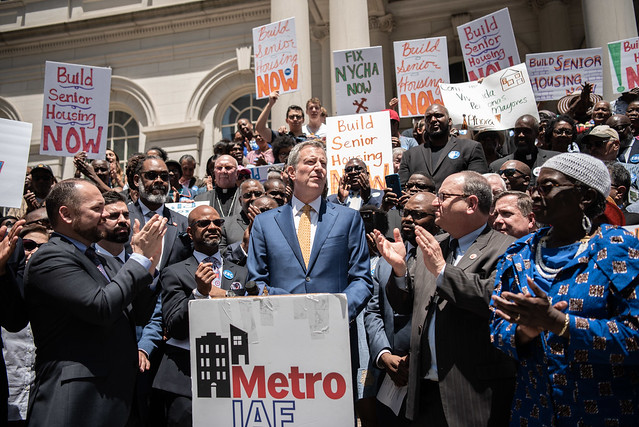
Mayor de Blasio rallies with Metro IAF (photo: Michael Appleton/Mayor's Office)
Last summer, Mayor de Blasio shook our hands and publicly promised to invest $500 million to build thousands of new apartments for low-income seniors. The celebration has been short lived. It turns out the mayor betrayed us and New Yorkers when he reneged on his commitment.
Last Tuesday, more than 500 East Brooklyn Congregations and Metro IAF leaders rallied on the steps of City Hall to get the money our seniors were promised. More importantly, we want the aspiring presidential candidate to come to grips with this cold and hard reality: the tale of two cities has grown worse not better over the past six years.
As pastors, we’ve spent the past 40 years organizing our people and pressuring public officials to deliver for the poor and working class of our city, many of whom worship in our pews or attend our schools.
We’ve had a relationship with every mayor. It’s often been contentious but never duplicitous.
In 1983, after a tough public fight with then-Mayor Ed Koch, we began the construction of what would eventually become more than 5,000 Nehemiah homes and apartments. The Nehemiah plan, named after the prophet who rebuilt Jerusalem, resurrected Brownsville, East New York, and large parts of the South Bronx.
Our city’s seniors will soon number more than 2 million. They stood by our city during the financial crisis of the 1970s, and the murder and drug epidemics of the ‘80s and ‘90s. We have a moral obligation to stand by them as they retire on fixed income and with a diminishing supply of affordable housing.
One of our older members recently confessed that trying to pay her $1,400 monthly rent on a fixed income sometimes forced her to choose between food and rent. We need a new Nehemiah plan for our city's seniors.
Mayor de Blasio came into office with talk of ending the tale of two cities. We believe his intentions were honorable, but, by all measurements, the affordable housing crisis, the dehumanizing conditions in NYCHA, and the future of many poor seniors and students are worse not better.
More than 65,000 of our fellow New Yorkers live in poorly-run shelters or expensive motels. At least 120,000 of our public school students are doubled up with family members or facing evictions.
Think about that. During times of prosperity and abundance, our young scholars are commuting from filthy shelters or far flung places. One of our high school students, her family evicted from their apartment in Bushwick, commutes every day from her relative’s home in Pennsylvania.
There are more than 200,000 seniors on wait-lists to get into affordable housing developments. With wait times as long as five to eight years, many die before they get to move in.
The blame for the housing crisis doesn't start and end at City Hall. Slumlords and mega-developers have learned how to monetize the eviction and displacement of hundreds of thousands of black and Latino families. They might be driving the crisis but the city cannot and must not stand idly by.
We spent two years pressuring and negotiating with the mayor to get him to do something truly transformational. It appeared that the mayor was finally ready.
On a bright sunny day last June, in front of 10 City Council members and hundreds of our members, the mayor promised to invest $500 million to create senior housing on empty NYCHA parking lots.
For every senior that we could voluntarily move out of New York City public housing, we could free up a three or four bedroom apartment for a family to leave the shelter. A $2 billion city investment can create 15,000 new affordable senior housing units which, in turn, can create space for 50,000 New Yorkers to move out of the shelters and off the streets.
The first $500 million can generate 4,000 new seniors units, which would mean that 12,000 or more individuals could get permanent affordable housing in NYCHA.
In a recent letter to Comptroller Stringer, the mayor quietly admitted that the $500 million is not in his budget plan. It’s gone, and so it appears is the mayor’s willingness to help.
We made this announcement at church services across the city over last couple of weeks. As pastors, we have rarely seen our people so angry. The mayor says there’s been unfortunate “confusion” about what he pledged, and claiming that the city's contribution would be much less, closer to $100 million.
We say it is only the mayor who has been confused.
It’s possible that the mayor, like a lot of public officials, never expected to be held accountable for his promise. But he is, and he must deliver.
***
By Rev. Adolphus Lacey, Rev. Shaun J. Lee & Rev. David K. Brawley.
***
Have an op-ed idea or submission for Gotham Gazette? Email This email address is being protected from spambots. You need JavaScript enabled to view it.
The Threat of the Trump Budget to New York City’s Social Safety Net is Very Real
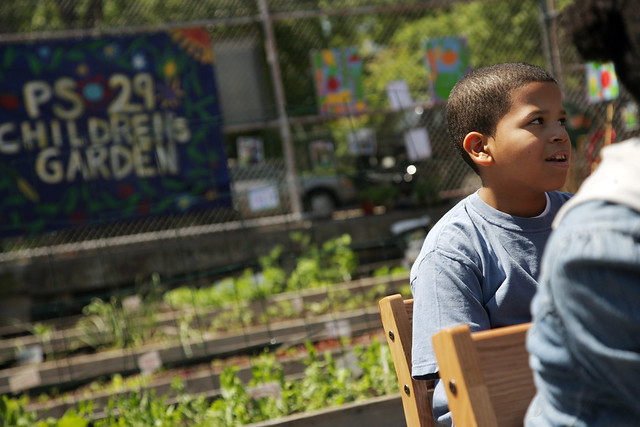
(photo: Ed Reed/Mayor's Office)
Last month, President Trump offered a cynical vision of the future with the release of his fiscal year 2020 budget. If enacted, it would deepen poverty and widen economic and racial disparities by denying millions health care and food, ramping up anti-immigrant enforcement, sabotaging the census, and disinvesting in housing and education. Meanwhile, the proposal prioritizes guns over butter by bloating the military budget and increases tax cuts to high-income taxpayers and heirs to very large estates.
FPWA analyzed the president’s budget by showing both the present danger to New York City and putting the proposal in context with historical funding trends, as illustrated in FPWA’s recently-launched Federal Funds Tracker.
According to our analysis, the proposal would collectively cut federal revenue to a handful of key human service agencies by nearly a half billion dollars (16 percent of their federal revenue) by ending or devastating programs that support the needs of communities, children and older adults, and those who are unable to afford a basic standard of living.
Although the president’s budget is non-binding, it is still of great concern because it is a statement of priorities from the country’s top officeholder, and unless an agreement is made before the coming fiscal year (which begins October 1), Trump’s deep cuts could become reality.
Moreover, a pattern has emerged in which the Trump administration turns to administrative action when its proposals fail to get through Congress, such as the proposed rule that would slash the Supplemental Nutrition Assistance Program (SNAP, formerly food stamps) by making it even harder for unemployed and underemployed workers to access food assistance, including 50,000 New York City residents.
We evaluate the impact of the proposal on the nearly 40 federal grants that support the four New York City agencies featured in the FPWA Federal Funds Tracker – the Administration for Children’s Services (ACS), Department of Youth and Community Development (DYCD), Department for the Aging (DFTA), and Department of Social Services (DSS) – and in turn, the nonprofit human service providers who rely on these grants.
These four agencies’ federal grants represented 38 percent ($2.9 billion) of the City’s total federal grants in FY 2018.
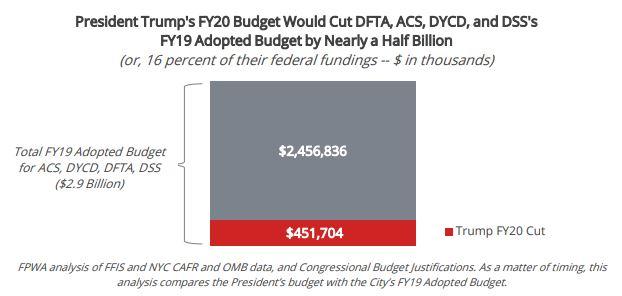
FPWA analysis of FFIS and NYC CAFR and OMB data, and Congressional Budget Justifications
Trump’s FY 2020 vision extends the economic pain that has endured throughout this decade into the next. Our analysis reveals that, adjusting for inflation, all federal grants to the City fell by nearly $2 billion since FY 2010, including hundreds of millions in support for human services.
In large part, disinvestment over the last decade is due to the 2011 Budget Control Act (BCA), which set caps on defense and nondefense discretionary funding through 2021 and further reduced funding over time through across-the-board spending cuts known as sequestration.
This disinvestment has real life consequences. Federal grants are often passed through from City agencies to nonprofit human-service providers to support the needs of their communities and attract and retain qualified staff.
For example, the Chinese-American Planning Council, Inc. relies on federal support to serve more than 60,000 individuals and families across Manhattan, Brooklyn, and Queens. CPC’s federal support would be cut by 44 percent ($2.5 million) under Trump’s budget, driven in part by the proposal to eliminate the Community Services Block Grants.
CSBG – which has already fell by 14 percent since FY 2010 – supports a wide range of community-based activities to reduce poverty, such as CPC’s LEAD program at the High School for Dual Language and Asian Studies. The LEAD program helped a struggling high school student assimilate into a new school, improve her language skills, and ultimately go on to be a successful student.
When the federal government abdicates its responsibility, New York City’s commitment to caring for people who are struggling to afford basic needs means that it is often left to fill the gaps. Indeed, since FY 2010, the City has invested an additional $2.2 billion (nominally) to support these agencies. In other words, the money that New York City spends on human services in the absence of sufficient federal support could be spent on other investments equally important to the City’s quality of life, such as transportation, safety, education, cultural institutions, and the environment.
Americans have already endured nearly a decade of federal austerity. Congress – which has begun work on FY 2020 spending bills – should chart a new vision for the new decade by reaching an agreement that not only reverses course on the planned sequestration cuts but also meaningfully increases support for the woefully underfunded programs that serve low-to middle-income families, and that, when properly funded, strengthen the economy and improve the quality of life for all New Yorkers.
***
Derek Thomas is Senior Fiscal Policy Analyst and Gaurav Gupta-Casale is Fiscal Policy Associate at FPWA. On Twitter @FPWA.
***
Have an op-ed idea or submission for Gotham Gazette? Email This email address is being protected from spambots. You need JavaScript enabled to view it.
SimCity Showed Us Brilliant Civic Tech Interfaces 30 Years Ago. We Should Build Them for Real Now

(SimCity image via nycj blogspot)
I was eight years old when I first encountered a computer game called SimCity. The general premise of the game was that you were the mayor of a virtual city, and you would use game money to create a place for communities of “Sims” to live.
First you set up basic infrastructure like roads, pipes, and zoning and soon after, the “Sims” would arrive to build buildings and pay taxes. As tax revenue flowed in, you would use it to make citywide improvements by establishing public infrastructure like schools, hospitals and parks. The more robust your city’s services, the more Sims would want to live there, and the more tax revenue would roll in. As the game progressed and your city grew, your decisions as mayor became increasingly complex. However, an easy-to-use interface simplified the tasks and made the whole experience a lot of fun.
That was 1994, and at the time, I assumed that one day, my neighbors and I would all have a hand in understanding and shaping New York City through tools and interfaces like SimCity’s. Apparently I wasn't the only one. A recent story in the LA Times claims that "'Sim City' inspired a generation of city planners."
As the internet was getting increasingly popular, my confidence in that idea strengthened. How difficult could it possibly be for the biggest city in the world’s richest country to create “Sim NYCity”?
Apparently it's quite difficult -- not from a technical perspective, but from an organizational development one.
Technically, government agencies have the vast majority of the data SimCity offers to viewers, such as geographic information like zoning and elevation; statistical information like crime and graduation rates and population; and infrastructure monitoring like traffic, electricity use, water flow rates, etc. But bringing it all together to give the residents an intelligible, (relatively) real-time dashboard for seeing their city operate clearly just isn't a priority.
Thanks to the tireless work of open source software developers and open government advocates, we don't have to wait for our city to organize this information for us. We can -- and should -- begin to do it ourselves.
Here are a few of the features that would make "SimNYCity" such a valuable contribution to civic life.
Interactive Community Maps
The centerpiece of the system is a map similar to Google Maps or the City's Planning Lab's new Community District Profiles website. It would have highly curated data layers that display education, health, police, fire and mass transit indicators (in SimCity parlance: data maps), as well as useful demographic information of residents.
Anyone could click a few layers on and off to see which neighborhoods have access to which services, and which don’t. Users could select which facilities they’d like to see added to an area, and then receive a projection of how the addition of such a facility would impact access in the neighborhood. Of course, accurate projections would be difficult to create, but basic estimates wouldn’t be, and more importantly, the existence of such a tool would whet the public’s appetite for more information and involvement in planning processes.
Citizen-Driven Budgets

[Offering opinions on the budget could be as easy as pulling a few sliders]
Managing the budget was one of the most important jobs of the mayor in SimCity. The tool for doing this was similar to a mortgage calculator. Income and expenses were presented with about 10 line items each, and you could pull the slider in one direction or another to change funding allocations and see how those allocations impact the entire city's budget.
We should offer a similar tool to New Yorkers. We can synthesize the New York City budget from thousands of line items into a dozen or so, enabling anyone to quickly see how money flows in and out of the city’s government. Then we can invite them to create their budget by pulling sliders. As they do, the city’s budget projections change.
So, if someone would like to increase the education budget they would toggle education to the right. Then they might adjust revenue by increasing taxes to balance the budget. Bonds could be included into the mix too by showing a list of public bond offers and requests. This type of tool would allow New Yorkers to create the budgetary mixes they want to see, and they can share it with others.
We could also generate statistics about all the different budgets New Yorkers create to develop insights about how the city’s budget could more accurately reflect the values of the city's residents.
Decision-Making Moments
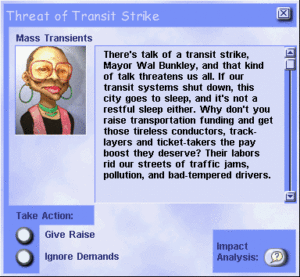
[City advisers could send out messages to New Yorkers and ask for their direct feedback]
When time sensitive decisions were needed in SimCity, a popup would appear with a message from an adviser asking the mayor for a decision. “SimNYCity” could work similarly by providing citizens with more opportunities to indicate their preferences on key civic issues.
For example, when a controversial zoning change is being proposed, an alert from the Commissioner of City Planning could be sent to SimNYCity users saying something like: "Residents are wondering what you plan to do with the Bedford Armory. Here's some information about the various interest groups. Do you think the current proposals should move forward or should it be rewritten?" Users could then say what they think.
This type of feedback could provide useful information for city leaders that they could incorporate into their decision-making processes. A similar workflow could be used for legislative and administrative decision-making.
Moving Beyond the Vote
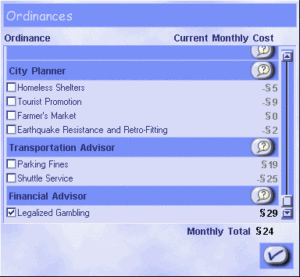
[Imagine if all the active and proposed city ordinances were laid out in a simple list]
Our current democratic processes are, unfortunately, failing New York City. Less than 25% of eligible New Yorkers voted in the 2017 election cycle, in which over 95% of incumbents won their primaries and went on to win uncompetitive general election races. This means that a very small group of Democratic Party insiders are the people determining who will serve in New York City government. That isn’t very democratic, and it's the main reason so few New Yorkers show up to the polls.
We don’t have to wait for deep reforms to our city’s democratic processes before we start experimenting with new and innovative ways to provide participatory democratic experiences to New Yorkers. We can offer citizens methods for engagement right now - and if these methods turn out to be popular, then we can organize the public to pressure existing politicians into incorporating these methods into their decision-making processes.
These are just a few interfaces SimCity has for making cities and their governments more legible, and interacting with them more enjoyable. The technical hurdles to implementing similar interfaces for the city are certainly significant, but not impossible to overcome.
Planning Labs, a digital service organization within New York City’s city planning agency is building open source software and open data resources that could power many of the complicated mapping elements. Furthermore, New York City's Open Data law mandates that much of the information we'd need from the government to build such a system is being published to the city's official Open Data Portal.
Exploring what that data is and how it can be connected together to build the type of deep data resources needed to power interfaces similar to SimCity's is the next step -- and it's work my team at Sarapis has begun to do by extracting and connecting nearly a dozen (and counting!) city datasets together to create data-driven government agency profiles that will make it easier for civic-minded people, especially journalists, to navigate and use for their work.
Through this process, we’re learning what data is and isn't available, how that data can be connected together and visualized to deliver insights to our users, and what next steps need to be taken on the long journey of delivering New Yorkers a SimCity style interfaces for their city.
***
Devin Balkind is the president of Sahana Software Foundation, founder of Sarapis.org, and a former candidate for New York City Public Advocate. He speaks regularly at conferences around the world about using technology to overcome environmental and political crisis. On Twitter @DevinBalkind.
***
Have an op-ed idea or submission for Gotham Gazette? Email This email address is being protected from spambots. You need JavaScript enabled to view it.
At 94%, New York Health Insurance Coverage Best of Four Most Populous States
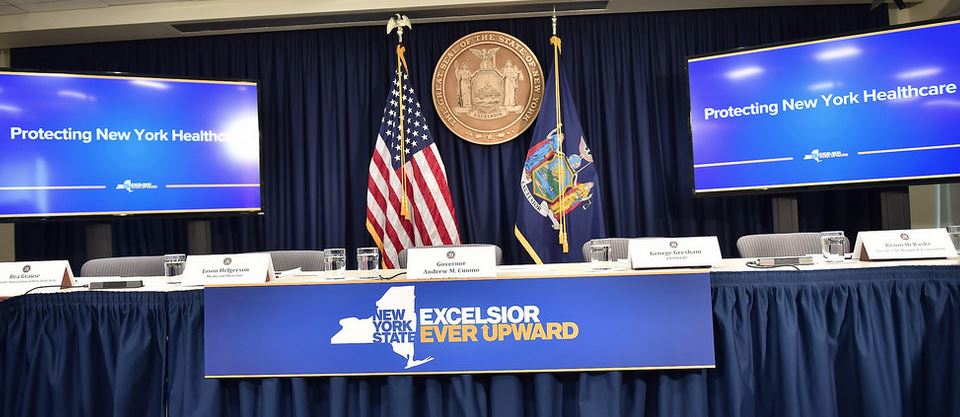
(photo: Kevin P. Coughlin/Office of Governor Andrew M. Cuomo)
New York State had achieved the highest percentage of residents with health insurance coverage of the four most populous states in the country by 2017, according to the Kaiser Family Foundation, one of the nation's leading health research organizations.
Ninety-four percent of New York's residents had health insurance coverage that year; California was second, with 93%. Both of these states accepted the Obamacare Medicaid Expansion, and both had 26% of their populations served by Medicaid in 2017. Texas and Florida, the other two of the four most populous states, both rejected the Medicaid expansion and had 83% insured and 87% insured, respectively. The United States as a whole had achieved 91% of its population covered by health insurance by 2017.

A report by State Comptroller Thomas DiNapoli actually pegged New York's health insurance coverage rate even higher in January 2018, at 95%, citing Center for Disease Control data. Either number for New York, 94 or 95%, reflects a solid record of attainment of social well-being in the state; not perfect, by any means, but very good.
So how did New York get there?
This article looks at how New York's policies achieved these positive results, as well as prospects for improvement.
First, however, it's useful to take a look at the immediate pre-Obamacare environment for the nation and these most-populous states, as well as how the states and the nation were faring in 1998-2000 as the Clinton administration came to a close in a period of substantial economic growth.
The following tables look at health coverage in the United States and the four big states in 2008 and 2010, as the Great Recession was beginning and ending.

In 2008, 15% of the nation's residents did not have health insurance and 13% were in the Medicaid program. In New York, 12% of residents were uninsured and 13% of residents were on Medicaid. By 2010, after the Great Recession, the uninsured had risen to 16% of the country, and 17% on Medicaid. In New York, uninsured was still 12%, but 22% were on Medicaid.
A 2001 U.S. Census Bureau report showed uninsured rates for 1998-2000. As the American economy continued to expand at the end of the Bill Clinton years, health insurance coverage reached 14% uninsured by 2000.
New York's situation was worse than the nation in 1998-2000, with 15.7% of its residents uninsured in 1998, and 15.1% uninsured in 2000.
In 2000, California had 17.9% uninsured, Texas 23.2%, and Florida, 17.2%. New York, at 15% uninsured, had a higher percentage of its residents with health insurance of the four largest states, but all four had higher levels of uninsured than the nation.
What happened? First: the Defeat of Block Grants for Medicaid
After the Republican Party won the House and Senate in 1994, the new Republican majorities passed legislation to limit Medicaid spending by providing a capped lump-sum amount of money for Medicaid to every state in the country, effectively eliminating the program as an entitlement. This lump sum was called a Block Grant.
Initially, welfare and other spending for poor people would also be given to states as a block grant. President Clinton vetoed this entire package in December 1995. New York Governor George Pataki made similar proposals, which were rejected by the Democratic-controlled Assembly. Ultimately, Clinton was able to force Congress to separate Medicaid from welfare, with welfare becoming the "Temporary Assistance to Needy Families" block grant (in New York), while Medicaid health care was preserved as an entitlement for the poor.
Enter Child Health Plus and Family Health Plus
In 1997, President Clinton proposed and Congress approved a program to expand health insurance coverage for children up to age 19. In 1999, the New York State Legislature passed legislation, which Governor Pataki signed, authorizing New York to apply for approval from the federal government for a program to be named Family Health Plus, enrolling the parents of children in Child Health Plus (CHP), up to 150% of the poverty level, in the Medicaid program.
Childless adults earning up to 100% of the poverty level would also be permitted to enroll. CHP in New York had enrolled over 500,000 children by 2001, and the federal government approved the Family Health Plus waiver. Implementation was planned for the fall of 2001.
A Health Emergency is Declared in New York After 9/11
The horrific impacts of the September 11, 2001 attacks on the United States and New York are known as part of American history.
But there was a side story about health care in New York that is less well-known. The New York State government's Medicaid computers were in the World Trade Center and were destroyed in the attacks.
These computers contained the information on the eligibility of those enrolled in the Medicaid program. Medicaid was very bureaucratic; recipients had to submit proof of their continued eligibility every year in a recertification process. After the Medicaid computers were destroyed, Governor Pataki announced on September 19, 2001 that New York had received an emergency waiver of the recertification requirements for Medicaid for New York City only through January 31, 2002.
A program known as Disaster Relief Medicaid was implemented that allowed persons to merely fill out a one-page document and attest they were eligible for Medicaid -- 350,000 people enrolled by the deadline.
New York's Family Health Plus program began its implementation shortly after 9/11 as well, allowing adults with children and earning up to 150% of the poverty line to enroll in Medicaid. A national recession was underway at the time of the 9/11 attack -- exacerbated in New York, of course, by the devastation in downtown Manhattan.
New York State lost nearly 200,000 jobs between August 2001 and August 2003, heavily concentrated in New York City. The confluence of all these events resulted in a major expansion of the Medicaid program in New York State; enrollment rose from 2.7 million in 2000 to 3.9 million in 2004.
New York State also began subsidizing small-group private health insurance through a program known as Healthy New York, where subsidized enrollment reached 145,000.
New York 2005-2013: The Great Recession, Medicaid Reform, Preparing for Obamacare
The New York State economy recovered from the recession and the Trade Center attack from 2003-2008, and the Medicaid rolls remained fairly stable, reaching 4.1 million in 2008. The Great Recession began in 2008, with the nation losing 8.5 million jobs from 2008 through February 2010.
New York lost more than 300,000 jobs and about 1 million residents were added to the Medicaid program, bringing Medicaid enrollment to about 5 million before Obamacare, enacted in 2010. This major new program, intended to provide health insurance to 30 million or more additional Americans, had a lead time of several years for the states to develop the ability to implement it.
The recession caused staggering New York State budget deficits. Struggling to cope, both Governors Paterson and Cuomo undertook intensive cost-containment efforts in the Medicaid program while maintaining and even enhancing eligibility. Participation in managed care became standard for Medicaid recipients, even the disabled. New York enacted some utilization limits and tightened reimbursement rates for providers. But the State still took steps to streamline and simplify Medicaid, such as allowing 12-month eligibility periods, eliminating the asset test and fingerprinting, affirming the experience of Disaster Relief Medicaid.
New York also accepted grants from the federal government to get Obamacare up and running by the beginning of 2014. New York integrated its Medicaid program with the new Obamacare health exchanges, in what became known as New York State of Health. Family Health Plus was folded into Obamacare. State government planned for the state to centralize Medicaid administration and take over enrollment processing for persons newly applying for Medicaid as well as the private health insurance plans offered on the exchanges.
Obamacare: 94-95% of New Yorkers Now Insured
By 2013 New York had reached 89% of its population covered by health insurance, and launched Obamacare in 2014. Another 1.2 million New Yorkers were enrolled in the Medicaid program and 250,000 in the new private plans during the Obamacare rollout.
New York adopted a screening policy for applications through the Exchange to enroll residents in Medicaid if they were determined to be eligible, resulting in New York's small private plan enrollments. After all, the federal government was covering 100% of the new costs up to 2019.
New York also received approval in 2015 from the federal government to add residents not eligible for Medicaid into a new insurance program called New York Essential Care, which now covers nearly 750,000, including adults from the Family Health Plus program whose eligibility for Obamacare Medicaid had not been preserved in the switchover. Comptroller DiNapoli's report cited New York as one of only two states in the country to create such a Plan (which is being paid 93% by the federal government). Adding this program to Medicaid enrollment (now 6 million plus) brings 7 million New Yorkers into non-Medicare public plans. 95% of New Yorkers now have health insurance.
The state government recently took important steps to codify elements of the Obamacare rollout into state law through the new state budget, protections toward stability in case there is significant undercutting of the health care law via the Supreme Court or other federal action.
Three Legislators
Three members of the New York State Legislature deserve special mention for extraordinary leadership in the state’s achievements in health insurance. One is Assemblymember Dick Gottfried of Manhattan, the senior member of the Legislature who has chaired the Assembly Health Committee since 1987. Second is State Senator Kemp Hannon, a Republican from Nassau County, who chaired the State Senate Health Committee and supported the Medicaid expansions and shepherded them through the Republican-controlled State Senate. He was defeated in 2018. And third, James Tallon, who served in the State Assembly from 1975-1993, as Majority Leader and Gottfried’s predecessor as chair of the Health Committee. He became President of the United Hospital Fund in 1993 and became the state’s intellectual leader in health care.
What’s Next?
New York still has 1 million to 1.2 million residents without health insurance. The Kaiser Foundation reports that 8% of New York non-elderly adults age 19-64 still do not have health insurance.
Recently the de Blasio administration announced a plan to enroll several hundred thousand more New York City residents without health insurance into a New York City insurance plan based on its network of municipal hospitals and clinics, which have their own Medicaid Managed Care Plan (the city is also attempting to enroll undocumented immigrants, who can’t be insured, into health care plans where they are assigned primary care doctors).
The city’s efforts are a good idea and the New York State government should help the city by paying for outreach and facilitated enrollment.
New York could still build on the substantial increases in health insurance outside New York City as well, and continue efforts to provide small group coverage through its Exchange. The top five states for insurance coverage in the nation have reached 96-97% of their residents insured.
And Single-Payer? Don’t Forget Donald Trump
The New York State Assembly has passed a single-payer health plan, called the New York Health Trust, several times, as recently as 2018,; it is now bill A. 5248 in the current legislative session.
Moving forward with such a plan still has innumerable hurdles, one of which involves folding the Medicare program into a comprehensive New York health insurance plan, necessitating federal government approval under the Trump administration, which is not likely. Single-payer must also pass the State Senate and be supported by Governor Cuomo.
Going into the 2020 presidential election, even if Donald Trump is defeated and the Democrats take back the United States Senate it's not certain there will be a national consensus on single-payer or Medicare-for-All. Incremental progress might still be the choice. It is clear New York State has made great progress and still has the capacity to do better, something New Yorkers should be proud of.
***
Jim Brennan was a member of the New York State Assembly for 32 years, where he chaired four committees. On Twitter @JimBrennanNY.
***
Have an op-ed idea or submission for Gotham Gazette? Email This email address is being protected from spambots. You need JavaScript enabled to view it.
Where We Work, ThriveNYC is Helping Families and Getting Homeless Children to School
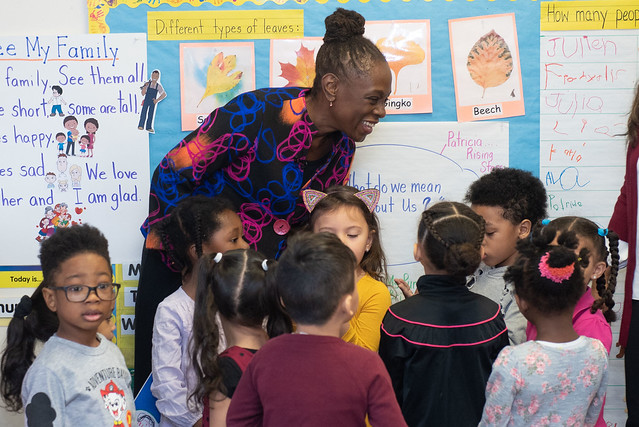
Chirlane McCray (photo: Michael Appleton/Mayoral Photography Office)
Questions have been raised recently about the cost and achievements of the ThriveNYC mental health initiative. This is no surprise: big, high-profile, efforts like ThriveNYC have always been susceptible to such criticisms.
But ThriveNYC is just the unifying umbrella of more than 40 different pilot programs attempting to deliver innovative mental health interventions across multiple city agencies. Organizing these disparate efforts into one initiative helped get resources for many long-needed mental health services unlikely to be funded on their own.
However, bundling these relatively small, experimental programs together into one big initiative makes them all a target in the event that just two or three of the interventions turn out to be ineffective, or take too long to get off the ground.
This is unfortunate, because in our experience, ThriveNYC provides critical new funding for skilled staff positions essential to our efforts to improve the quality of services to homeless families.
For example, we have long known that homeless children struggle to attend school regularly. Just 34% of homeless children have “good” attendance (90% of school days or better), while over 73% of their housed counterparts meet this threshold. Low school attendance is one of the most damaging outcomes of family homelessness, with often-lifelong negative consequences for children who fall behind in their educational progress.
Gateway Housing and its partners are reducing chronic absenteeism among homeless children through our Improving School Attendance for Homeless Children (ISAHC) initiative. Piloted at three city shelters operated by nonprofit providers BronxWorks, Win, and HELP USA, the ISAHC initiative uses data, training, and coordination to identify and assist families struggling to get their kids to school.
In just its first four months, the ISAHC program has already achieved measurable improvements: one-third of homeless students who were chronically absent or worse have now improved to good attendance under ISAHC, and we believe further progress is likely.
The ISAHC initiative could not have achieved these positive outcomes without staff funded by ThriveNYC.
Better coordination and a laser focus on attendance identifies kids who aren’t getting to school. But every day, we come across children with poor attendance whose families are experiencing severe mental health issues. We refer these families to new specialists employed by DHS’ nonprofit shelter providers, called Client Care Coordinators. Over 300 Client Care Coordinator positions in nonprofit-run family shelters have been created with ThriveNYC funding.
Before ThriveNYC, we would have had very little to offer the children of homeless families facing the most complex challenges. With ThriveNYC, we now have a chance to help them and their families with professional interventions not available before the initiative existed.
Service providers are seeing similar benefits of ThriveNYC-funded initiatives that expand access to Naloxone, provide mental health services in youth shelters, and offer Assertive Community Treatment mental health teams, to name three more ThriveNYC programs that are demonstrating real results for the most vulnerable New Yorkers.
Measuring the performance of new interventions is important – no one wants to spend taxpayer dollars on ineffective programs. That’s why Gateway Housing has independent researchers tracking ISAHC to see if it works, and whether it can be replicated at other shelters.
But implementing effective social services takes time and experimentation. While the jury may be out on some of ThriveNYC’s more ambitious initiatives, we have clear evidence that at least some of its resources are making a measurable difference for homeless children, today and for the rest of their lives.
Mental health needs are all too often overlooked and underfunded. We should preserve ThriveNYC funding to continue the good work already achieved by its most effective programs, and to give its more daring, experimental efforts a chance to demonstrate success.
***
Ted Houghton and Brendan Cheney are President and Associate Director of Gateway Housing, a nonprofit organization that works to improve the homeless shelter system. On Twitter @Gateway_Housing.
***
Have an op-ed idea or submission for Gotham Gazette? Email This email address is being protected from spambots. You need JavaScript enabled to view it.
A Solution in New York City School Turnaround is Simpler Than We Think
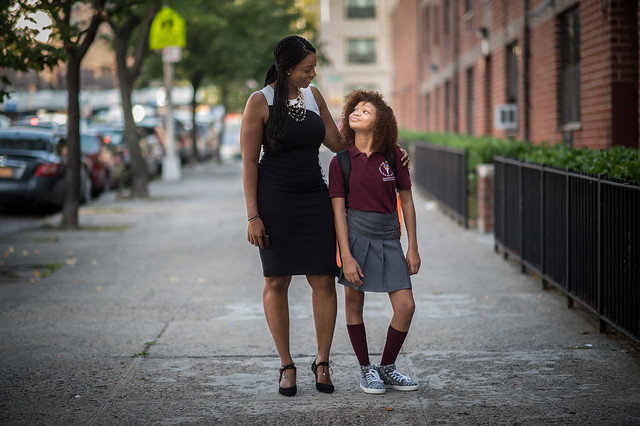
(photo: Michael Appleton/Mayoral Photography Office)
Recently, amid a debate about a jarring lack of diversity in New York City’s specialized schools, jaw-dropping news broke. A RAND Corporation Report, commissioned by the Department of Education, showed that despite roughly $750 million spent on fewer than 100 “Renewal Schools,” the needle fundamentally failed to move on student outcomes.
Extraordinary resources were expended. Real results never materialized.
Now, questions abound as to how the city should move forward to improve struggling schools. Was the problem rooted in faulty bureaucratic execution and implementation that hampered the Renewal program from the beginning? Do we begin closing more schools and reopening them anew?
We need answers as tens of thousands of children of color live in poverty, more than 100,000 students were homeless last year, and countless others don’t know where their next meal is coming from. History has shown that complex social issues often yield equally complex – and exceptionally expensive – solutions, and policymakers seem to be focused on finding the sweeping, systemic “special sauce” for delivering meaningful student gains.
But the reality is that sometimes the most vexing issues can have simple answers. And what’s so often overlooked is an elegant, bread-and-butter approach to setting our kids up for success: an adult mentor.
An adult outside of the home and classroom who cares for the student and asks for nothing in return. An adult who regularly checks in with the student, offers guidance, and believes in and encourages him or her. This makes a huge difference to young students. Offering mentoring programs for students in need is comparatively very cheap and replicable, and serves as a poverty-fighting tool.
And it’s something that doesn’t exist at scale right now.
We know all of this because our organization, Student Sponsor Partners, pairs students entering high school and in extreme need with professional adults who work with them. A full 100% of kids in our program have average to below-average test scores coming into high school, 100% live below the poverty line, and 76% live in one- or no-parent households. Yet, we couple robust mentoring with scholarships to private high schools, and our kids have an 85% on-time graduation rate and 92% college attendance rate.
And beyond the numbers are the stories that prove mentorship works. I am an example of just that. By the age of 12, I had been in and out of foster homes. That’s when I met Peter Flanigan, founder of Student Sponsor Partners, who became my mentor and changed my life forever. He saw potential in me, and him believing in me and pushing me to be my best self helped me get to where I am today.
From NYPD officers to executives at Fortune 500 companies, mentors make a huge difference by committing to our program and guiding students in their spare time. Often, these relationships last through high school, college, and for the rest of their lives.
A citywide mentoring program can be an anti-poverty tactic – and a tool to help diversify top public schools. Every year, our program serves nearly 1,200 students across New York City.
But the sheer shortage of adults caring for students outside the classroom in our public schools is concerning. For every 1,000 students, there are only 4.9 support workers, far fewer than comparable cities. Nationwide, the average student-to-school-counselor ratio is a shocking 482-to-1. Our city’s “single shepherd” program, aimed to address the lack of guidance counselors, came with a $50 million price tag yet officials are unable to say if it’s made an impact.
Guidance counselors and school staff are doing what they can, but it’s virtually impossible to give children and their parents personalized attention when a support worker is responsible for hundreds of cases.
It’s no wonder that educational gaps persist.
So, as we have a citywide conversation about how to achieve equity and success, and give every student a fair shot at a great education, we may not want to search for a panacea. Instead, policymakers would do well to start by focusing on the basics.
The conversation about how to move forward after the Renewal Schools failure cannot just focus on how to achieve the right outcomes through a handful of schools or through an expensive policy. It also must focus on how we prevent a generation of children, who are deeply in need, from falling permanently behind, and how we give students most in need the academic tools to succeed long-term.
The city can start by launching a comprehensive mentoring program, linking adult New Yorkers who want to give back with kids who need support most.
It can make a world of difference to an individual child – and be game-changing across our school system.
***
Debra De Jesus-Vizzi is the executive director of Student Sponsor Partners in New York City. On Twitter @DebraVizzi & @sspnewyork.
***
Have an op-ed idea or submission for Gotham Gazette? Email This email address is being protected from spambots. You need JavaScript enabled to view it.
Policymakers Can’t Have It Both Ways If They Want to Save Jobs
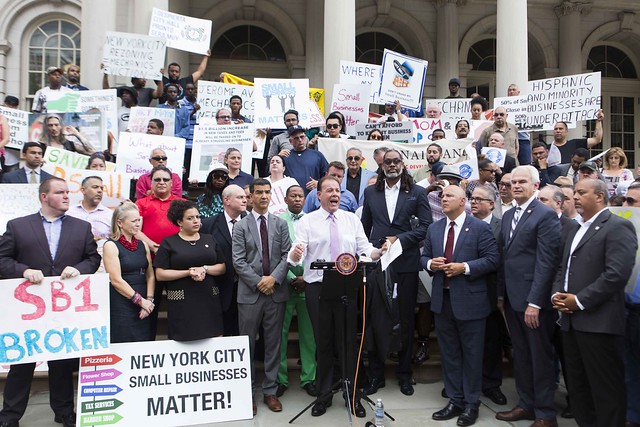
(photo: Emil Cohen/City Council)
The number of jobs in New York City reached an all-time high this year, bringing the unemployment rate to record lows. We are the envy of the nation. But there is one key sector where jobs are declining. For the first time in more than a decade, we are seeing job losses among restaurants and food service establishments.
In an attempt to halt some of these losses, City Council Members Brad Lander and Adrienne Adams introduced legislation to prohibit employers from firing fast food workers without just cause, meaning for any reason other than misconduct or failure to perform job duties. They cite surveys showing that many fast food workers who have been terminated or had their hours cut were given no explanation as to why.
While well-intentioned, this proposal misses the mark because it ignores the underlying causes.
It’s as if lawmakers are trying to have it both ways by, first, imposing costly new requirements on businesses and, then, preventing them from making the difficult but legitimate staffing changes necessary to comply.
Small business owners certainly do not want to eliminate jobs. There is no joy derived from laying off employees. But the reality is that local regulations have so fundamentally altered the way that businesses operate here that employers often have no choice but to eliminate some positions in order to stay afloat.
Consider just a few of the mandates recently imposed on local businesses.
New York’s minimum wage has increased every year since 2013, reaching $15 an hour for most businesses in the city this year. This has been difficult for some to absorb because government has implemented other costly mandates at the same time.
In May 2013, the New York City Council passed legislation requiring employers with 20 or more workers to provide at least five days of paid sick leave. The following year the law was expanded to capture small businesses with as few as five employees.
In 2016, New York State’s Paid Family Leave Act was adopted, requiring businesses of all sizes to accommodate up to 10 weeks of paid leave for employees to care for a new child, care for family members that are ill, or assist loved ones when a family member is deployed abroad on active military duty.
These are all incredibly important initiatives, but the truth is that someone has to pay for them.
When the Manhattan Chamber of Commerce surveyed our members last year, small businesses cited the high cost of doing business in New York as the thing most negatively affecting them. Yet instead of helping small businesses compete more effectively, policymakers have signaled that more costly mandates are on the way.
Mayor de Blasio wants to force businesses with five or more employees to provide each with two weeks of paid vacation. Most medium and large companies already offer generous paid time off benefits, so it is primarily small businesses that will bear the brunt.
Similarly, lawmakers in Albany are considering eliminating the tip credit, which would dramatically increase payroll costs at restaurants and certainly trigger more job losses.
Is it any wonder that small businesses don’t feel that local government has their back?
If compliance with the law imposes perpetually-increasing costs of operation, businesses simply cannot raise prices at a rate that consumers will accept. Consequently, business owners are forced to cut costs wherever possible, including jobs. Preventing businesses from making those decisions will not save jobs; it will simply spell the end for many businesses.
The bottom-line: If lawmakers truly want to protect jobs, they must give regulatory relief to the businesses that provide those jobs and stop pretending that they can have it both ways.
***
Jessica Walker is President of the Manhattan Chamber of Commerce. On Twitter @jessinharlem & @ManhattanCofC.
***
Have an op-ed idea or submission for Gotham Gazette? Email This email address is being protected from spambots. You need JavaScript enabled to view it.
Governor Cuomo Has Just Weeks to Embrace a Real Green New Deal for New York

Gov. Cuomo (photo: governor's office)
As debate over the Green New Deal has seized the nation, the young people of Sunrise Movement have been challenging politicians to answer a simple question: What is your plan?
In April, the New York City Council rose to that challenge with a series of bills that sets a high-water mark for urban climate action across the globe. Mayor de Blasio is expected to sign the Climate Mobilization Act soon.
Governor Cuomo, meanwhile, has allowed the Climate and Community Protection Act (CCPA), the most ambitious climate legislation in the country, to languish in Albany. “I don’t see anything specific for the rest of the session” in terms of environmental legislation, the governor said recently -- a shocking statement considering the lack of climate action coming from Albany -- about the state government agenda before the legislative session ends mid-June.
Climate change is an existential threat for my generation. Young people deserve more than lip service from leaders who have consistently failed to confront the crisis over the past decade.
New Yorkers know this. We’ve seen the impacts of climate change and fossil fuel pollution in record-breaking heat waves, devastating hurricanes like Superstorm Sandy, and overwhelmingly high rates of asthma and other respiratory diseases. We know we need to act urgently to meet the scale of the challenge.
To his credit, Governor Cuomo put forth a vision for climate action in his executive budget. He calls it a Green New Deal. Unfortunately, his plan is not worthy of the name.
The young people of Sunrise ask politicians to share their plans so that we can see who is serious about tackling climate change and who is not. We have three criteria for judging what constitutes a serious plan to address the crisis.
First, the Green New Deal needs to transition the entire economy to clean energy. Governor Cuomo only sets enforceable decarbonization targets for the electricity sector.
Second, the Green New Deal needs to make sure resources flow directly to the communities hit hardest by climate change – particularly communities of color and low-income neighborhoods. The governor talks about environmental justice – but his plan fails to put his money where his mouth is.
Finally, the Green New Deal needs to center the good, family-supporting jobs that will be created through investments in renewable energy. The governor’s proposal doesn’t yet outline a comprehensive way to make that happen.
Here’s the thing: the Climate and Community Protect Act, which predates Governor Cuomo’s ‘Green New Deal,’ would accomplish these three needs. The CCPA is a vision for climate justice that has been improved and expanded and revised for almost four years with the support of over 150 community, labor, and environmental organizations.
Spearheaded by a coalition called NY Renews, the CCPA is the holistic approach to the climate crisis that New Yorkers deserve. The coalition’s plan sets a legally enforceable timeline to get New York’s entire economy off of fossil fuels by 2050 while also ensuring that 40 percent of state funding goes to frontline and vulnerable communities (low-income and communities of color, among others, facing the brunt of environmental harms), and that the green jobs created are also good jobs that follow prevailing wages and provide training and apprenticeships when possible.
The federal Green New Deal resolution introduced by Rep. Alexandria Ocasio-Cortez has broken new ground for its success in bringing climate change to the fore in Congress. But in New York, the CCPA has for years been a model for climate legislation that centers both good jobs and healthy communities.
Climate change, pollution, and environmental harms have exacerbated systematic inequality by disproportionately affecting indigenous communities, communities of color, migrant communities, deindustrialized communities, depopulated rural communities, the poor, low-income workers, women, the elderly, the unhoused, people with disabilities, and yes, youth like young climate strikers and the Sunrise members that have been showing up nationwide to push their representatives toward climate action.
Governor Cuomo says he wants to be at the forefront of the climate movement — framing his proposals as a ‘Green New Deal’ demonstrates as much. But the way New York should lead the climate movement is by modeling the power of community-focused action. The governor’s plan wouldn’t get us to 100 percent renewable energy economy-wide, and it doesn’t include the kinds of provisions we need for jobs or justice. Superstorm Sandy has already showed us how necessary it is to invest in the frontline communities hit hardest by the climate crisis. No justice, no deal.
The CCPA, however, enshrines in law an enforceable timeline to eliminate fossil fuels throughout New York by 2050, meaning that New Yorkers will not only have a plan, they will have recourse to ensure the state follows through.
The CCPA has passed the State Assembly three times already, only to be stopped by what used to be the climate change-denying, Republican Senate leadership. That’s changed now, and Democratic Senate Majority Leader Andrea Stewart-Cousins has embraced the CCPA and its coalition of community, labor, and environmental groups.
If Governor Cuomo can’t commit to supporting the CCPA, then the state legislature needs to force his hand by putting the bill on his desk.
In 2019, all climate action is long past due. With the federal Green New Deal stalled in Congress thanks to fossil fuel executives and their allies in Republican leadership, what we need now is for our state leaders to step up. The CCPA is ready, and New Yorkers are ready too.
The question is, is the governor?
***
Matthew Miles Goodrich is New York State Director of Sunrise Movement. On Twitter @mmilesgoodrich & @sunrisemvmt.
***
Have an op-ed idea or submission for Gotham Gazette? Email This email address is being protected from spambots. You need JavaScript enabled to view it.
Manhattan GOP Goes Full Trump, Ruining Chances for Years to Come

(photo: @RealDonaldTrump)
Well, it’s happened. The barbarians have finally sacked the city.
On February 1, Trump enthusiast Ian Walsh Reilly assumed the leadership of the Metropolitan Republican Club, one of the oldest Republican clubs in New York City. Like Trump, Ian’s the kind of guy who bumps elbows with high-profile racists and unrepentant misogynists like Gavin McInnes, founder of the alt-right nationalist group The Proud Boys.
Ian just couldn’t wait to get Gavin in front of his club’s membership last year, and this epic lapse in judgment resulted in a nearly 24-hour cycle of violence and vandalism – on Manhattan’s tony Upper East Side no less.
Then, on April 20, Ian’s lickspittle lackey Gavin Wax and sidekick Vish Burra claimed top spots at the New York Young Republican Club. (Wax is currently facing criminal charges of Forcible Touching and Sexual Abuse, while Burra was charged with felony drug possession in 2015.)
These organizations form the backbone of the Manhattan GOP’s voter and volunteer base, and are now firmly under the control of Trumpist alt-right acolytes, which puts Manhattan Republican Party Chair Andrea Catsimatidis in a bit of a bind.
Trump lost Manhattan in the 2016 GOP Primary to John Kasich, and scored less than 10% of the vote borough-wide on Election Day. For a party organization tasked with recruiting candidates, raising money, and winning elections, I’m stumped as to what their endgame strategy is.
No serious New York City candidate will ever run on a Republican ticket with Trump, and no candidate who embraces Trump will ever win in the city (outside of Staten Island – and sometimes not even there).
Could the ascent of people like Wax, Burra, and Reilly be a sign that local County Committees and their ancillary groups have simply thrown in the towel on ever building a real party apparatus, and have instead opted to simply cash in on the rubes and dupes and Pizzagate pushers that comprise the monochromatic Trump coalition?
Sure seems like it.
If Trump wins re-election in 2020, his personality and policies will undoubtedly reshape the current Republican Party for many years to come. But if Trump is defeated, then the GOP, especially in urban areas, will have a unique opportunity to redefine what it means to be a Republican in the 21st Century.
However, those who embraced Trump, either half-heartedly or with bear hugs, won’t be able to make that case. Sorry, but Trump taint just don’t bleach.
New York City constitutes nearly half the statewide vote, and from day one, it’s been abundantly clear that Trump does not share the city’s values.
But until Manhattan and other borough Republicans disavow, disassociate, and condemn the president, a majority of city voters simply won’t give two cowpats about what ideas we have on public housing, higher education, infrastructure, jobs, student debt, and criminal justice reform.
If our leaders refuse to assert themselves at the grassroots level – or worse yet, co-opt the alt-right message, then the GOP in the Empire State is doomed.
We need our County Chairs and State Party officers to lead, to communicate to young people and veteran activists alike what a winning strategy and message look and sound like. Hint: it’s not Donald J. Trump.
But if they’re either unwilling or unable to do so, then perhaps the time has come for experienced operatives and establishment groups, who have so far largely stood on the sidelines and quietly seethed, to strike back with a vengeance in order to preserve the party of Teddy Roosevelt so that it won’t be spoken of in the same breath as ‘pussy’-grabbers, conspiracy theorists, and xenophobes.
***
John William Schiffbauer is a political consultant, and was the Deputy Communications Director for the New York Republican State Committee from 2014 to 2016. On Twitter @JWSGOP.
***
Have an op-ed idea or submission for Gotham Gazette? Email This email address is being protected from spambots. You need JavaScript enabled to view it.




